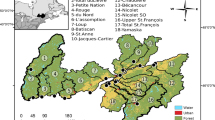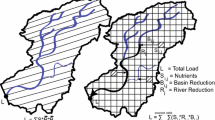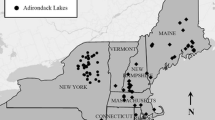Abstract
Nutrient loading to lakes depends on both the availability of nutrients in a watershed and their potential for movement to a lake. Many studies have demonstrated that variation in watershed land use can translate to differences in lake water quality by affecting nutrient availability. There have been few attempts, however, to understand how loading to surface waters is affected by land use when there are differences in watershed transport capacity. We compared the relationship between land use/cover and lake nutrients in lakes draining watersheds that exhibited high and low transport capacity using a 5 year (2001–2005) dataset describing the chemistry of 101 lakes and reservoirs in a region of intensive agriculture. We measured watershed transport capacity by compositing the hydrologic, geologic, and topographic variables correlated with interannual variability in lake total nitrogen (TN) or phosphorus (TP) because the hydrologic permeability of watersheds amplifies downstream responses to rainfall events. Factors describing watershed transport capacity differed for TN and TP, consistent with differences in nutrient mobility and biogeochemistry. Partial least squares regression revealed that watershed transport capacity influenced the nature of the association between land use/cover and lake chemistry. In watersheds with low transport capacity, in-lake processes and near-shore land use/cover tended to be more influential, whereas, in watersheds with high transport capacity, land use/cover across the entire watershed was important for explaining lake chemistry. Thus, although land use is a key driver of nutrient loading to lakes, the extent to which it influences water quality can vary with watershed transport capacity.





Similar content being viewed by others
References
Allan D, Erickson D, Fay J 1997. The influence of catchment land use on stream integrity across multiple spatial scales. Freshw Biol 37:149–61.
Allan JD 2004. Landscapes and riverscapes: the influence of land use on stream ecosystems. Annu Rev Ecol Evol Syst 35:257–84.
Arbuckle KE, Downing JA 2001. The influence of watershed land use on lake N:P in a predominantly agricultural landscape. Limnol Oceanogr 46:970–5.
Buck O, Niyogi DK, Townsend CR 2004. Scale-dependence of land use effects on water quality of streams in agricultural catchments. Environ Pollut 130:287–99.
Canfield DE, Bachmann RW 1981. Prediction of total phosphorus concentrations, chlorophyll-alpha, and secchi depths in natural and artificial lakes. Can J Fish Aquat Sci 38:414–23.
Carpenter SR, Caraco NF, Correll DL, Howarth RW, Sharpley AN, Smith VH 1998. Nonpoint pollution of surface waters with phosphorus and nitrogen. Ecol Appl 8:559–68.
Clesceri LS, Greenberg AE, Eaton AD, Eds. 1998. Standard methods for the examination of water and wastewater. Washington, D.C: American Public Health Association.
Correll DL, Jordan TE, Weller DE 1999a. Effects of precipitation and air temperature on nitrogen discharges from Rhode River watersheds. Water Air Soil Pollut 115:547–75.
Correll DL, Jordan TE, Weller DE 1999b. Effects of precipitation and air temperature on phosphorus fluxes from Rhode River watersheds. J Environ Qual 28:144–54.
Creed IF, Band LE 1998. Export of nitrogen from catchments within a temperate forest: evidence for a unifying mechanism regulated by variable source area dynamics. Water Resour Res 34:3105–20.
Crumpton WG, Isenhart TM, Mitchell PD 1992. Nitrate and organic N analyses with second-derivative spectroscopy. Limnol Oceanogr 37:907–13.
D’Arcy P, Carignan R 1997. Influence of catchment topography on water chemistry in southeastern Quebec Shield lakes. Can J Fish Aquat Sci 54:2215–27.
David MB, Gentry LE, Kovacic DA, Smith KM 1997. Nitrogen balance in and export from an agricultural watershed. J Environ Qual 26:1038–48.
Dillon PJ, Kirchner WB 1975. Effects of geology and land use on export of phosphorus from watersheds. Water Res 9:135–48.
Eriksson L, Hermens JLM, Johansson E, Verhaar HJM, Wold S 1995. Multivariate-analysis of aquatic toxicity data with PLS. Aquat Sci 57:217–41.
Fraterrigo JM, Rusak JA 2008. Disturbance-driven changes in the variability of ecological patterns and processes. Ecol Lett 11:756–70.
Fridén H, Koivula K, Wold S 1994. SIMCA for Windows, Version 5.1. Umeå: UMETRI AB.
Gergel SE 2005. Spatial and non-spatial factors: when do they affect landscape indicators of watershed loading? Landsc Ecol 20:177–89.
Gergel SE, Turner MG, Kratz TK 1999. Dissolved organic carbon as an indicator of the scale of watershed influence on lakes and rivers. Ecol Appl 9:1377–90.
Gergel SE, Turner MG, Miller JR, Melack JM, Stanley EH 2002. Landscape indicators of human impacts to riverine systems. Aquat Sci 64:118–28.
Heathwaite L, Sharpley A, Gburek W 2000. A conceptual approach for integrating phosphorus and nitrogen management at watershed scales. J Environ Qual 29:158–66.
Howarth RW, Billen G, Swaney D, Townsend A, Jaworski N, Lajtha K, Downing JA, Elmgren R, Caraco N, Jordan T, Berendse F, Freney J, Kudeyarov V, Murdoch P, Zhu ZL 1996. Regional nitrogen budgets and riverine N&P fluxes for the drainages to the North Atlantic Ocean: natural and human influences. Biogeochemistry 35:75–139.
Hunsaker CT, Levine DA 1995. Hierarchical approaches to the study of water quality in rivers. Bioscience 45:193–203.
Jeppesen E, Meerhoff M, Jacobsen BA, Hansen RS, Sondergaard M, Jensen JP, Lauridsen TL, Mazzeo N, Branco CWC 2007. Restoration of shallow lakes by nutrient control and biomanipulation: the successful strategy varies with lake size and climate. Hydrobiologia 581:269–85.
Jeppesen E, Sondergaard M, Jensen JP, Havens KE, Anneville O, Carvalho L, Coveney MF, Deneke R, Dokulil MT, Foy B, Gerdeaux D, Hampton SE, Hilt S, Kangur K, Kohler J, Lammens E, Lauridsen TL, Manca M, Miracle MR, Moss B, Noges P, Persson G, Phillips G, Portielje R, Schelske CL, Straile D, Tatrai I, Willen E, Winder M 2005. Lake responses to reduced nutrient loading: an analysis of contemporary long-term data from 35 case studies. Freshw Biol 50:1747–71.
Johansson ME, Nilsson C 2002. Responses of riparian plants to flooding in free-flowing and regulated boreal rivers: an experimental study. J Appl Ecol 39:971–86.
Johnson LB, Richards C, Host GE, Arthur JW. 1997. Landscape influences on water chemistry in midwestern stream ecosystems. Freshw Biol 37:193–208
Jones JR, Knowlton MF, Obrecht DV, Cook EA 2004. Importance of landscape variables and morphology on nutrients in Missouri reservoirs. Can J Fish Aquat Sci 61:1503–12.
Jones KB, Neale AC, Nash MS, Van Remortel RD, Wickham JD, Riitters KH, O’Neill RV 2001. Predicting nutrient and sediment loadings to streams from landscape metrics: a multiple watershed study from the United States Mid-Atlantic Region. Landsc Ecol 16:301–12.
King RS, Baker ME, Whigham DF, Weller DE, Jordan TE, Kazyak PF, Hurd MK 2005. Spatial considerations for linking watershed land cover to ecological indicators in streams. Ecol Appl 15:137–53.
King RS, DeLuca WV, Whigham DF, Marra PP 2007. Threshold effects of coastal urbanization on Phragmites australia (common reed) abundance and foliar nitrogen in Chesapeake Bay. Estuar Coasts 30:469–81.
Kleinman PJA, Srinivasan MS, Dell CJ, Schmidt JP, Sharpley AN, Bryant RB 2006. Role of rainfall intensity and hydrology in nutrient transport via surface runoff. J Environ Qual 35:1248–59.
Lewis DB, Grimm NB 2007. Hierarchical regulation of nitrogen export from urban catchments: interactions of storms and landscapes. Ecol Appl 17:2347–64.
Logan TJ, Eckert DJ, Beak DG 1994. Tillage, crop and climatic effects on runoff and tile drainage losses of nitrate and 4 herbicides. Soil Tillage Res 30:75–103.
Martin SL, Soranno PA 2006. Lake landscape position: relationships to hydrologic connectivity and landscape features. Limnol Oceanogr 51:801–14.
McArdle BH, Gaston KJ, Lawton JH 1990. Variation in the size of animal populations: patterns, problems and artifacts. J Anim Ecol 59:439–54.
McCune B, Grace JB 2002. Analysis of ecological communities. Gleneden Beach, Oregon, USA: MjM Software Design.
Müller B, Lotter AF, Sturm M, Ammann A 1998. Influence of catchment quality and altitude on the water and sediment composition of 68 small lakes in Central Europe. Aquat Sci 60:316–37.
Muscutt AD, Withers PJA 1996. The phosphorus content of rivers in England and Wales. Water Res 30:1258–68.
Nürnberg G, Peters RH 1984. The importance of internal phosphorus load to the eutrophication of lakes with anoxic hypolimnia. Verh Int Ver Limnol 22:190–4.
Omernik JM 1976. The influence of land use on stream nutrient levels. Washington, D.C: U.S. Environmental Protection Agency.
Omernik JM 1977. Non-point source stream nutrient level relationships: a nationwide study. Corvallis, Oregon, USA: U.S. Environmental Protection Agency.
Omernik JM, Abernathy AR, Male LM 1981. Stream nutrient levels and proximity of agricultural and forest land to streams: some relationships. J Soil Water Conserv 36:227–31.
Osborne LL, Wiley MJ 1988. Empirical relationships between land use/cover and stream water quality in an agricultural watershed. J Environ Manage 26:9–27.
Reckhow KH, Beaulac MN, Simpson JT. 1980. Modeling phosphorus loading in lake response under uncertainty: a manual and compilation of export coefficients. U.S. Environmental Protection Agency.
Reed-Andersen T, Carpenter SR, Lathrop RC 2000. Phosphorus flow in a watershed-lake ecosystem. Ecosystems 3:561–73.
Riera JL, Magnuson JJ, Kratz TK, Webster KE 2000. A geomorphic template for the analysis of lake districts applied to the Northern Highland Lake District, Wisconsin, USA. Freshw Biol 43:301–18.
Schilling KE, Wolter CF 2005. Estimation of streamflow, base flow, and nitrate-nitrogen loads in Iowa using multiple linear regression models. J Am Water Resour Assoc 41:1333–46.
Sharpley AN, Syers JK 1979. Phosphorus inputs into a stream draining an agricultural watershed. Water Air Soil Pollut 11:417–28.
Sims JT, Simard RR, Joern BC 1998. Phosphorus loss in agricultural drainage: historical perspective and current research. J Environ Qual 27:277–93.
Søndergaard M, Jensen JP, Jeppesen E 1999. Internal phosphorus loading in shallow Danish lakes. Hydrobiologia 408:145–52.
Søndergaard M, Jensen JP, Jeppesen E 2003. Role of sediment and internal loading of phosphorus in shallow lakes. Hydrobiologia 506:135–45.
Søndergaard M, Kristensen P, Jeppesen E 1992. Phosphorus release from resuspended sediment in the shallow and wind-exposed Lake Arreso, Denmark. Hydrobiologia 228:91–9.
Soranno PA, Hubler SL, Carpenter SR, Lathrop RC 1996. Phosphorus loads to surface waters: a simple model to account for spatial pattern of land use. Ecol Appl 6:865–78.
Soranno PA, Webster KE, Riera JL, Kratz TK, Baron JS, Bukaveckas PA, Kling GW, White DS, Caine N, Lathrop RC, Leavitt PR 1999. Spatial variation among lakes within landscapes: ecological organization along lake chains. Ecosystems 2:395–410.
Spears BM, Carvalho L, Perkins R, Kirika A, Paterson DM 2007. Sediment phosphorus cycling in a large shallow lake: spatio-temporal variation in phosphorus pools and release. Hydrobiologia 584:37–48.
Stone M, Brooks RJ 1990. Continuum regression: cross-validated sequentially constructed prediction embracing ordinary least-squares, partial least-squares and principal components regression. J R Stat Soc Ser B Methodol 52:237–69.
Strayer DL, Beighley RE, Thompson LC, Brooks S, Nilsson C, Pinay G, Naiman RJ 2003. Effects of land cover on stream ecosystems: roles of empirical models and scaling issues. Ecosystems 6:407–23.
Tomer MD, Meek DW, Jaynes DB, Hatfield JL 2003. Evaluation of nitrate nitrogen fluxes from a tile-drained watershed in central Iowa. J Environ Qual 32:642–53.
Van Herpe Y, Troch PA 2000. Spatial and temporal variations in surface water nitrate concentrations in a mixed land use catchment under humid temperate climatic conditions. Hydrol Process 14:2439–55.
Walter MT, Walter MF, Brooks ES, Steenhuis TS, Boll J, Weiler KR 2000. Hydrologically sensitive areas: variable source area hydrology implications for water quality risk assessment. J Soil Water Conserv 3:277–84.
Wold S 1978. Cross-validatory estimation of the number of components in factor and principal components models. Technometrics 20:397–405.
Wold S 1995. PLS for multivariate linear modeling. In: Waterbeemd Hvd (Ed.), Chemometric methods in molecular design: methods and principles in medicinal chemistry. Weinheim, Germany: Wiley-VCH Verlag GmbH. pp 195–218.
Wold S, Albano C, Dunn WJ, Esbensen K, Hellberg S, Johansson E, Lindberg W, Sjöström M 1984. Modeling data tables by principal components and PLS: class patterns and quantitative predictive relations. Analusis 12:477–85.
Acknowledgements
This work benefited from discussions with Lucinda Johnson and Mike Burkhart. Thanks are due to George Antoniou, Jessica Davis, Jingyang Li, and Zsolt Gemesi for technical support, and to Pat Soranno, Erik Jeppesen, and three anonymous reviewers for their comments on an earlier draft of this manuscript. Funding for our study was provided by the Iowa DNR. JMF was supported by the National Research Initiative of the USDA-CSREES, grant #2005-35102-16291.
Author information
Authors and Affiliations
Corresponding author
Additional information
JMF conceived the study and analyzed the data. JAD collected the data. JMF and JAD wrote the paper.
Rights and permissions
About this article
Cite this article
Fraterrigo, J.M., Downing, J.A. The Influence of Land Use on Lake Nutrients Varies with Watershed Transport Capacity. Ecosystems 11, 1021–1034 (2008). https://doi.org/10.1007/s10021-008-9176-6
Received:
Revised:
Accepted:
Published:
Issue Date:
DOI: https://doi.org/10.1007/s10021-008-9176-6




